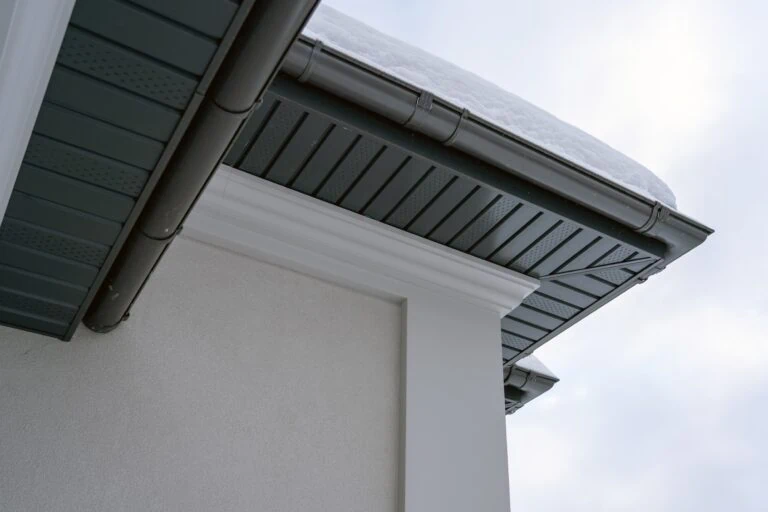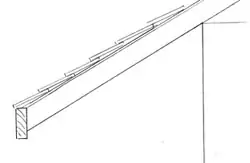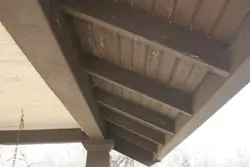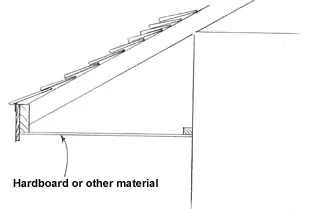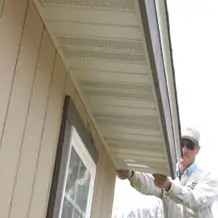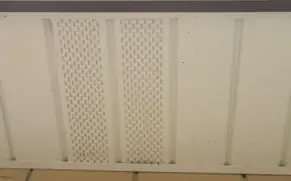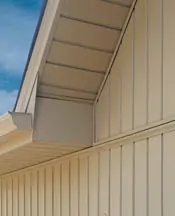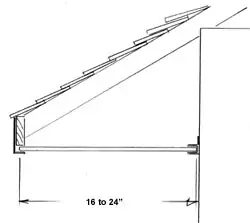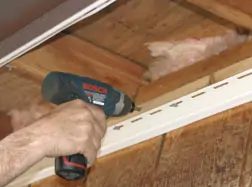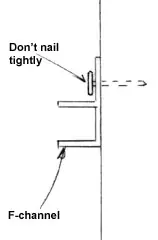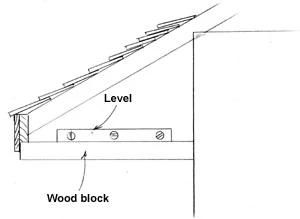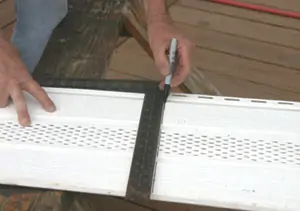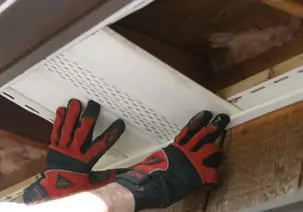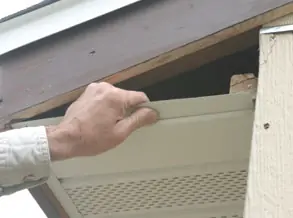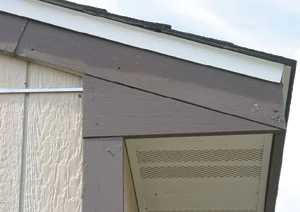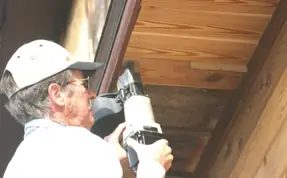Soffits are the Rodney Dangerfield of home construction—they’re mostly unseen and often the last detail to get attention. They’re just plain unglamorous. They are, however, extremely important to the longevity and comfort of your home.
House eaves may be open without soffits, common in new construction, or closed off with soffits. the latter is normally a remodeling chore.
Soffits are actually part of the cornice or eave, the point where the roof projection and the side walls of the building meet. Hip roofs have a continuous cornice that extends completely around the building. A gable roof has a cornice along the side walls, formed at the rafter ends. Most gable roofs also have a rake cornice or rake extension formed on the gable ends. This is created by extending the rafters out past the building ends. Not only does the cornice add to the appearance of the home, it also helps protect the building from sun, rain and snow. In most instances the cornice or eave of today’s homes are finished off with a soffit—the covering on the underside of the overhang. Older homes often have an open eave, with the rafters adding to the décor. These homes can be left as is, or soffits can be added.
Some older homes have open eaves. These can be repaired, or soffits can be installed to create closed eaves.
Closed eaves may be wide or narrow, depending on the roof design. On narrow eaves the rafter ends serve to fasten the soffit and fascia. A ledger plate is fastened to the wall to attach the soffit at that location. Wide eaves require additional nailing supports running from the rafter-ends/fascia board and back to the house wall. These are called lookouts. The drawings in this article illustrate the various types of eave and soffit construction.
Soffits must be designed and installed properly. One of the most important factors is proper ventilation. If soffits are not ventilated, they can cause the formation of ice dams at the eaves. As the attic warms from the house heat, it allows the roof surface to melt snow, or ice, which then runs down into the colder eave surfaces and freezes back again. This creates an ice dam that allows water to work its way back into the walls and ceilings of the house. Venting both the attic with eave vents and the soffit with vent systems increases air circulation and prevents this problem. Ventilation not only prevents ice dams, but helps reduce heat build-up in the summer.
Soffit installation is fairly easy, even for a first-timer.
Material Options
A variety of materials are used for soffits. Wood and wood products, such as tempered hardboard, were an early choice. If redoing an older home and you desire to stay with tradition, this may be the choice. Metal ventilating screens are available for wood soffits. Metal soffits have also been common. One of the most popular soffit materials, however, is vinyl. Both metal and vinyl are available in a variety of colors to match metal and vinyl house siding. These materials offer the advantage of no painting or finishing and little maintenance. These soffits come in preformed lengths that are cut to fit into matching, preformed receiving channels to hold the soffits in place (in the same manner as metal or vinyl siding installation). Soffit installation or replacement is easy with these materials, even for a first-timer. Metal or vinyl soffits also come as solid panels or perforated to provide ventilation.
Soffit materials may be vinyl, metal or wood. Ventilated soffit materials can help prevent winter ice dams and keep the home cooler in the summer months.
The type of soffit installation depends on the type of material and the eave construction. You should also check local building codes for the amount of ventilation required in your area, as well as the required or suggested application methods. This may also depend on the windloads in some areas. One factor is the maximum permissible span of the soffit material. Soffits usually range from 16 to 24 inches wide. For instance, CertainTeed Ironmax soffits may span 24 inches without additional nailing strips, if permitted by code rules.
Vinyl is one of the most popular soffit materials. It’s available in a wide range of colors and requires little maintenance. (Photo courtesy of CertainTeed)
The installation also depends on whether the eave construction is open or closed. Open eave construction, where the rafters or trusses are exposed, is common on new construction. Closed eave, where an existing soffit is in place, is typical of remodeling projects. Rotted or deteriorated wooden soffits should be removed before installation of new vinyl soffits.
Installation of vinyl depends on the type of construction, open or closed eave, and whether the fascia cap is to be applied.
You may also wish to install a vinyl fascia cap over the fascia board that encloses the front of the eave. In this case the fascia cap or coil stock must be installed first as it supports the outer edge of the soffit.
First step is to apply the receiving channel or channels, depending on the type of installation needed.
Installation
The first step is to determine the amount of material needed. To determine the number of squares of soffit required, measure the under-eave areas and multiply the length by the width for each overhang. Add up the total of all overhangs and divide the total by 100 to determine the number of squares. Next measure the total linear feet of installation components, including: F-channel, J-channel, H-bar, undersill trim and fascia. Add 10 percent to your total for waste and miscalculation.
Fasten the receiving channel in place to the house wall or to a nailing strip.
Prep the area by nailing all loose boards and trim securely in place. Remove any downspouts or lighting fixtures that are in the way. Tie back trees and shrubbery so you have easy access to the eaves.
Allow for expansion and contraction when nailing in place. Don’t drive nails tight.
Open eave installation of a vinyl soffit begins by first installing the proper receiving channels. Either F-channel or J-channel can be used. J-channel can be modified to create F-channel. Simply cut slots in the nail flange area where it would be nailed to the wall. After cutting the nail flange, bend the flange back and nail to the wall.
Use a block of wood and level to determine the location of the receiving channel on the house wall at each end of the run. Then snap a chalk line.
Before installation, however, you must first determine the channel location on the wall. Cut a block of wood that fits between the back or bottom of the fascia, depending on the installation, and the house wall. Position the block in place and use a short level to mark a level line at each end of the eave. Then snap a chalk line between the two. Install the receiving channels, nailing every 16-inches with the nail centered in the nailing slot. Do not nail tightly, but allow for expansion and contraction movement. In some instances of spans greater than 16 inches, it may be necessary to install nailing strips and then fasten the channels on the nailing strips. At each corner, cut and install the channel so there is a 1/4-inch expansion at each of the adjoining walls.
Measure and mark the soffit panel to fit between the receiving channels, less 1/4-inch gap for expansion (3/8-inch gap in freezing weather). Cut the panels using a pair of heavy-duty snips, or a portable circular saw with a fine-toothed blade turned backward. Be sure to wear saftey goggles and protective gloves.
Measure between the receiving channels and then subtract 1/2-inch to allow for expansion. Make this measurement on a soffit panel, using a framing square to mark a square cut. You can cross-cut the panel using a power circular saw with a reversed fine-toothed blade. Actually, you can cut two panels at the same time in this manner.
Insert the panel end into the wall receiving channel, then either insert into the fascia channel or nail to the fascia. Continue cutting and installing the panels, locking them together as you go
.
Once the panels are cut, place the cut panel into the channel on the wall, then into the channel on the fascia board. You will probably have to slightly flex the panel to get it in place. Make sure the panel is perpendicular to the wall and not “canted.” The panel is held in place with small-headed nails driven into the fascia board or nailing strip. If nailing into the fascia board, drive the nail through the nail flange and the “V” groove. This is one of the few times when face nailing of the soffit material is permissible. Once nailed in place the soffit can only expand toward the receiving channel, so make sure you leave enough space for expansion in the receiving channel. Continue the panel installation, locking and nailing the soffit in place. Make sure all panels are securely locked in place the entire length of the soffit run.
Metal soffit is installed in much the same manner.
To turn a corner, measure from the channel at the wall corner to the channel at the corner of the fascia board, subtract 1/4-inch for expansion. Install a soffit double-channel lineal or H-bar. Nailing strips may be required. Miter the soffit panels to fit into the H-bar or lineal channel.
In most instances you will want to close off the eave with a cornice box of some sort.
Basically, installation over an enclosed eave is done much in the same manner. First remove rotted or damaged wooden soffits. If installing over an existing soffit and it doesn’t have ventilation openings, cut openings in it before installing the vinyl soffit in place. In most instances you will close off the gable end fascia with a cornice box or a fascia end cap.
Corners are formed by using an H-bar and mitering the panels into the bar.
Installation of a wooden soffit is in much the same manner, except nailing strips are first fastened in place. The soffit materials are then nailed to the wooden support strips.
In the case of an older home restoration, or to create a “custom” look, you can use wood soffits. In this case Western Red Cedar Siding was applied to the home and the soffits recovered with matching
siding pieces.
Soffit installation is really fairly simple, but it does take some ladder work, so make sure you follow all ladder safety rules. Wear safety goggles when cutting vinyl or aluminum soffit materials. You should also wear a pair of leather or protective work gloves.


